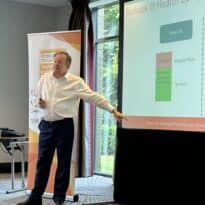Paul Wilcox, Chairman, WAY Trustees Limited, considers the issues, challenges and potential solutions for helping clients who have been using pensions as IHT mitigating instruments.
General Budget warning: Readers should note that many or some of the measures announced in the recent budget on 30 October 2024, and commented on below, may be subject to change. There are already some indications that the government may vary the announcement concerning agricultural property relief, plus there is an ongoing consultation regarding the detail and process for the announced imposition of inheritance tax on pensions and related death benefits (which consultation does not conclude until the 22 January 2025). Furthermore, significant opposition to the measures from across farming and the business sector in general, as well as from government and opposition ministers, means that there will inevitably be at least some minor tweaking ahead of the actual legislation (the resulting Finance Bill).
However most importantly, as announced at the Autumn Budget, from April 2027, the majority of unused pension funds and death benefits will be included within the value of a person’s estate for Inheritance Tax purposes, and pension scheme administrators will become liable for reporting and paying any Inheritance Tax due on them to HMRC. The consultation is focused only on the administration of these measures, the ‘how’ but not on either the ‘if or when’! IHT on pensions is coming down the track and so today is not too early to take avoiding action.
What does all this mean?
So, what does this radical and unexpected move mean for financial planners and their pension clients, many of whom have been using pensions as their primary tool to avoid Inheritance Tax (IHT), rather than simply as a means of funding their retirement? Many such clients have hitherto had little intention of spending their accumulated pension funds and, instead, have expected to pass those funds onto their families free of IHT. They have been wealthy enough to survive without drawing any substantial funds from their pensions.
And Death Benefits?
Post age 75 the overall value of death benefits will suffer both immediate IHT and subsequent Income Tax when residual funds are taken by beneficiaries. Pre 75 death benefits paid as a lump sum in excess of the Lump Sum Death Benefits Allowance (LSDBA) will also suffer both of these taxes.
Spousal Exemption
In spite of these changes the spousal exemption is to remain intact so that any pension/death benefit sums left to a surviving spouse or civil partner continue to be free of IHT but will then form part of their IHT taxable estate.
Where from here then?
With these historical IHT benefits being removed, there is now little incentive to focus on building those pension pots for the benefit of HMRC then taking a ‘double dip’ of IHT and beneficiary Income Tax, following the pension saver’s demise. So, what should such a pension saver do next? Clearly, depending on their individual circumstances, and specifically if their pension has been deliberately over-funded for retirement purposes, they might like to consider:
1. Stopping or reducing their ongoing pension funding if they are yet to reach retirement age.
2. Take their maximum 25% tax-free cash and immediately gift it into a (family-based) discretionary, reversionary interest, trust. This will become IHT-free once they survive 7 years – which based on mortality tables virtually all such clients will.
3. Initiate and or increase their taxable pension income to allow them to commence gifting ‘regular annual amounts’ from that after-tax pension income, into a ‘gifts from income’ (family-based) discretionary, reversionary interest, trust whereby all such segregated value is then immediately IHT exempt.
A brief description of these uniquely valuable personal trusts appears later in this article.
Big Picture thoughts
These changes to the pension rules as regards IHT are due to come into force in 2027 so there remains time for all potentially-affected parties to rethink their financial/pension planning arrangements ahead of that date. This does not mean that one should put off making changes, since some of the benefits of doing so can be time sensitive – such as gifting into trust where the 7 year rule means there can be significant advantage in getting that clock ticking sooner rather than later.
The primary message for those with ‘over-funded’ pension pots (taking full account of one’s likely retirement needs) is to remove as much of ones newly IHT taxable funds from those pensions as one conveniently and efficiently can. This includes choosing to draw down as much regular income as is comfortable, taking into account both the impact on personal Income Tax and wider financial planning considerations, to redirect into IHT exempt regular gifts into a personal family trust.
How will IHT be paid and will it delay probate?
It is suggested that IHT will be charged on the gross value of one’s pension funds, as at the valuation point immediately prior to their death. Any resulting tax will be settled direct to the HMRC by each pension provider.
Will probate be delayed by HMRC involvement in calculating IHT? I personally hope not because I suspect a ‘first’ probate submission may completely ignore the pension liability (which in any case is between the pension company and HMRC) and only if the declared taxable personal estate – excluding pensions – is in excess of a certain level (for example, say £1.5m) will you be obliged to temporarily remove the additional Residential Nil Rate Band (RNRB). HMRC will then be able to reduce any IHT chargeable on the pension element to take account of reinstating all or part of the RNRB or even refund any overpaid IHT. The worst case scenario is they will probably just further delay probate.
These are the extremely tricky aspects of the recent announcement. Imagining an already overworked HMRC having to deal with and calculate or check IHT issues with multiple pension providers for very many individual taxpayers – it beggar’s belief!
The early establishment of a suitable personal trust is already one of many solutions available to overcome the issue of potentially delayed probate, as a byproduct of their inherent flexibility.
Discretionary Reversionary Interest Trusts
Trusts have been a highly useful means of wealthy people protecting their own and their family’s assets for several centuries. Protecting them from all kinds of interference, as well as from taxes. Having a segregated store of value looked after by trusted discretionary trustees, who will ‘stand in your stead’ can protect assets from all sorts of ‘interference’ such as creditors, ex-spouses, dysfunctional families, the tax man and/or many other dangers including modern financial ‘scams’.
The common, and the most frequently used, discretionary trusts are extremely effective overall, being IHT exempt if the Settlor survives the 7th anniversary of establishing the trust. However, their biggest drawback is that the Settlor – the person gifting funds or assets into trust – is excluded from being a beneficiary and cannot benefit from such trusts without destroying their IHT effectiveness. This makes them challenging, because most elderly clients seeking an IHT solution are generally concerned about losing access to what were previously their own carefully accumulated ‘reserve’ funds.
There is one unique variety of such trusts, however, which overcomes this issue by creating legally separate rights within the trust, linked to reversions specified within the trust deed, allowing the trustees to revert trust assets to the Settlor, but only if and when it is deemed necessary. Such gifts into these trusts are deemed to be Lifetime Chargeable Transfers for IHT purposes and are therefore limited to any available unused Nil Rate Band for IHT (currently £325,000). Any transfers in excess of this will suffer lifetime rates of IHT of 20% and so most such trusts are established within that band. This is convenient because it aligns with the maximum tax-free cash available from larger pension funds of £268,275.
The issue here is that most Settlors gift away value within such trusts in spite of being uncertain about their potential needs for the future, simply because they know their trustees will make funds available to them should they ever face unexpected needs. Once they have survived 7 years they can make a further gift of the then current Nil Rate Band – a typical Settlor of such trusts is aged 70 and therefore can likely have two or three bites of the cherry, since life expectation at that age is around 15 years. It is probably not too early to start the exemption clock ticking!
Gifts from Income Reversionary Interest Trusts
A similar style of trust, again with reversionary interest wording, is available to benefit taxpayers that have available surplus after-tax income which they would like to protect from IHT. Imagine some Premier League footballers, high-rolling City Executives, successful artists/musicians/actors and so forth who enjoy a brief few years earning massive incomes. Many such people need or wish to have a mechanism for putting some of their gainful and temporarily high earnings away in a segregated and protected environment.
HMRC has long recognised the peculiarity of such circumstances and there exists an exception to IHT where regular and surplus after-tax income can be gifted away within a complete and instant IHT exception, but only so long as it (a) really is regular (normally meaning for a likely/planned period of at least 3 years), (b) Income Tax has already been paid on it, and (c) making such gifts does not impair/impinge on one’s normal standard of living – all of which will likely need to be proven, if required.
Some advisers have floated the concept of gifting £20,000 per annum (or more) of any available and surplus after-tax income into such a trust – achieving instant IHT exemption. Outcome – continuing market performance and no IHT. It has been pointed out the significant difference between this strategy compared with continuing with ISA funding, and accordingly judged ‘no contest’.
Are such trusts an ideal solution?
Both varieties of these Discretionary Reversionary Interest Trusts have been available for some years but remain relatively unknown and under-used. However, since they are so flexible and in design could easily have been created especially for this ‘taxing of pensions’ moment, they really have come into their own.
The bottom line is that clients who are overfunding, or with already overfunded, pension plans, which were established primarily as an IHT mitigation device, have a ready-made partial solution which allows them to divert pension funds, either tax-free cash and/or regular excess net pension income into highly flexible and IHT efficient trusts which come with a long and successful track record.
Main image: hector-j-rivas-1FxMET2U5dU-unsplash



























